Revolution or Evolution? Technical Requirements and Considerations towards 6G Mobile Communications
Abstract
:1. Introduction
2. Evolution of Mobile Communication
3. Use Cases and Applications of 6G
- -
- Transportation: autonomous vehicles interacting with the environment and cooperating driving.
- -
- Retail: near real-time and end-to-end no-touch transactions from production to consumption.
- -
- Manufacturing: autonomous and dynamic reconfigurable production lines based upon near real-time demand.
- -
- Healthcare: robotic controlled surgery, remote surgical procedures, and enhanced precision surgical capabilities.
- -
- Industrial/Public: cooperative manufacturing, massive embedded intelligence, low-power sensor deployment across supply chain and surroundings.
- -
- High fidelity gaming: Play instantly without download, subscription enabled, and direct distribution model.
- -
- Robotic construction: autonomous worksite equipment, real-time on-site planning and construction.
- -
- Instantaneous delivery: massive fleet logistics and dynamic delivery locations.
- -
- Autonomation: process autonomation, cognitive process autonomation, virtual agents and analytics, AI- and machine learning (ML)-based execution, and intelligent enterprise.
- -
- Truly immersive extended reality (XR): Combining VR, AR, and mixed reality (MR) and utilizing it in entertainment, medicine, science, and education.
- -
- High-fidelity mobile hologram: as a next-generation of media technology to provide real-time services.
4. Requirements of 6G
- (1)
- Spectrum efficiencies 5 to 10 times higher than those of 5G;
- (2)
- Peak data rate of at least 1 Tbps or up to 10 Tbps in some instances that involve THz wireless backhaul and fronthaul (x-haul) [46];
- (3)
- User experienced data rate of 1 Gbps or even up to 10 Gbps in certain cases (e.g., indoor hotspot);
- (4)
- Ten times higher connectivity density than that of 5G which can sustain up to 107 devices per area (in km2) and area traffic capacity of up to 1 Gbps per area (in m2) for hotspot;
- (5)
- A wireless network that can support various (or at times, conflicting) requirements [47];
- (6)
- High mobility (≥1000 km/h) and over-the-air latency of 10–100 μs for acceptable quality of experience (QoE) in cases that involve hyper-HSR and airline systems;
- (7)
- Huge connection density up to 107 devices/km2, which means 10 times the connectivity density of 5G; in addition, area traffic capacity of up to 1 Gbps/m2 for scenarios such as hotspots;
- (8)
- 10–100 times higher energy efficiency than in 5G;
- (9)
- 5–10 times greater spectrum efficiency than in 5G.
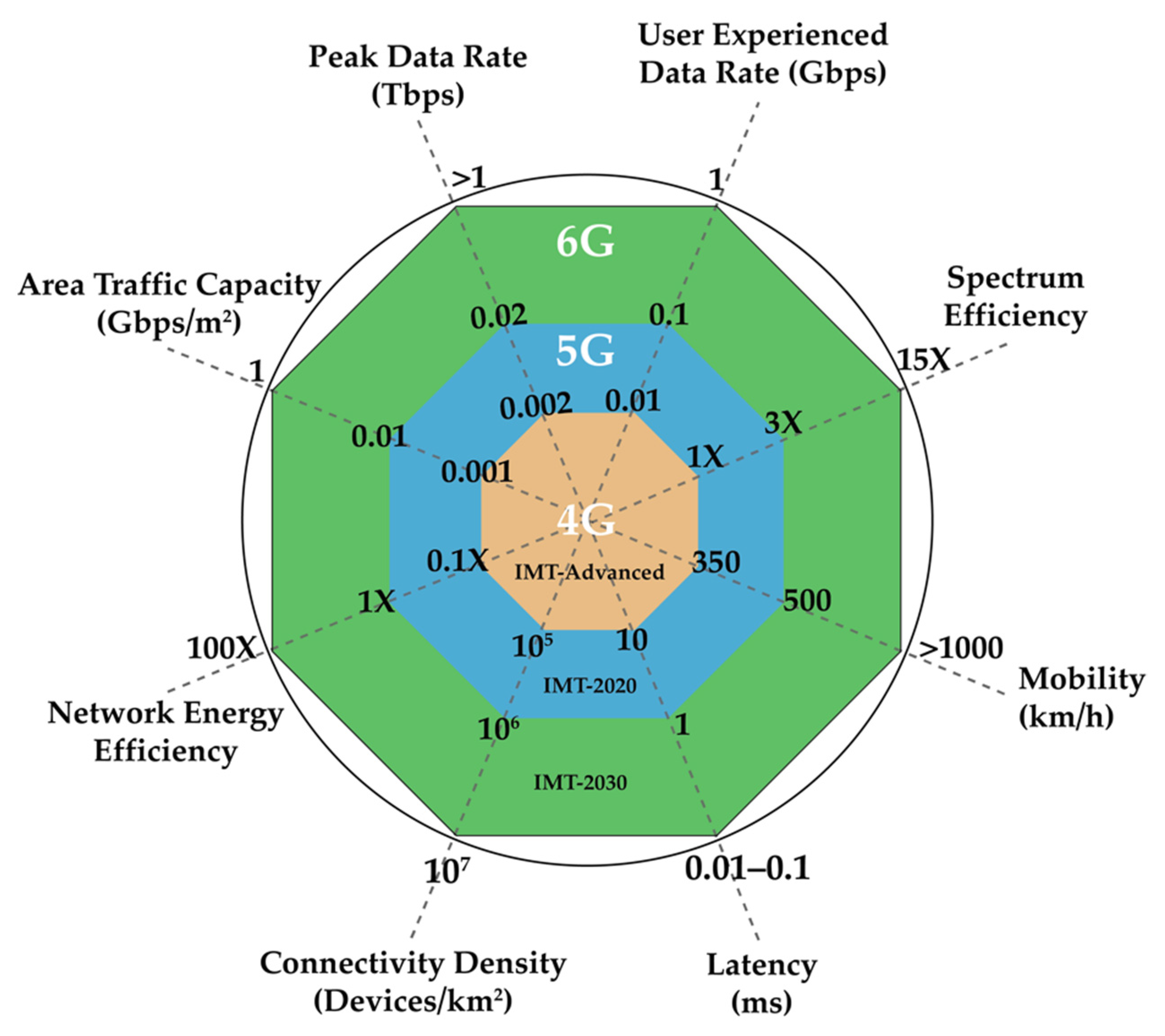
5. 6G RF Spectrum Technologies
5.1. THz Spectrum
5.2. Visible Light Spectrum
6. Enablers for 6G and Relevant Technical Preparation and Implementation
6.1. THz Communication
6.2. Holographic Beamforming
6.3. Cell-Free mMIMO (CF-mMIMO) Technology
6.4. Artificial Intelligence (AI)
6.5. Blockchain
6.6. Quantum Communication
- relies on qubit;
- accelerates processing data for ML and deep learning models;
- allows for the simultaneous processing of millions of devices;
- allows for more efficient handling of vast amounts of data.
6.7. Edge Intelligence
6.8. Intelligent Reflecting Surface (IRS)
6.9. New Multiple Access Techniques
6.10. New Coding Techniques
6.11. Zero-Energy Interface
7. Challenges of 6G
7.1. Device Capability
- Hardware for the research and development of 6G is still not ready. Having equipment and modern labs helps the developers and devices designers to test and develop the devices and produce compatibility with 6G technology.
- The industry standard is still not finalized. There are no standards for the devices that can work with 6G, which complicates things for the device’s manufacturer. Furthermore, organizations such as 3GPP, which provides mobile technology standardization, have still not defined the standards of 6G technology.
7.2. THz Band
7.3. Network Security
8. Future Directions in 6G Technology Development
8.1. Intensive Academia–Industry Research and Development Works
8.2. High-Speed Mobile Experience
8.3. AI-Enabled Networking
8.4. Harmonized Networks
8.5. Sustainable Networks
8.6. Extreme Global Network Coverage
8.7. Security, Privacy, and Trust
9. Conclusions
Author Contributions
Funding
Institutional Review Board Statement
Informed Consent Statement
Data Availability Statement
Conflicts of Interest
References
- Shayea, I.; Azmi, M.H.; Rahman, T.A.; Ergen, M.; Han, C.T.; Arsad, A. Spectrum Gap Analysis with Practical Solutions for Future Mobile Data Traffic Growth in Malaysia. IEEE Access 2019, 7, 24910–24933. [Google Scholar] [CrossRef]
- David, K.; Berndt, H. 6G vision and requirements: Is there any need for beyond 5G? IEEE Veh. Technol. Mag. 2018, 13, 72–80. [Google Scholar] [CrossRef]
- Yang, P.; Xiao, Y.; Xiao, M.; Li, S. 6G wireless communications: Vision and potential techniques. IEEE Netw. 2019, 33, 70–75. [Google Scholar] [CrossRef]
- Benn, H. Hyper Connectivity with 6G; TelecomTV, 2020. Available online: https://www.telecomtv.com/content/what-next-for-wireless-infrastructure-summit/hyper-connectivity-with-6g-40147/ (accessed on 12 December 2021).
- Andrews, J.G.; Buzzi, S.; Choi, W.; Hanly, S.V.; Lozano, A.; Soong, A.C.; Zhang, J.C. What will 5G be? IEEE J. Sel. Areas Commun. 2014, 32, 1065–1082. [Google Scholar] [CrossRef]
- Shayea, I.; Abd. Rahman, T.; Hadri Azmi, M.; Arsad, A. Rain attenuation of millimetre wave above 10 GHz for terrestrial links in tropical regions. Trans. Emerg. Telecommun. Technol. 2018, 29, e3450. [Google Scholar] [CrossRef]
- De Alwis, C.; Kalla, A.; Pham, Q.-V.; Kumar, P.; Dev, K.; Hwang, W.-J.; Liyanage, M. Survey on 6G frontiers: Trends, applications, requirements, technologies and future research. IEEE Open J. Commun. Soc. 2021, 2, 836–886. [Google Scholar] [CrossRef]
- Huang, T.; Yang, W.; Wu, J.; Ma, J.; Zhang, X.; Zhang, D. A Survey on Green 6G Network: Architecture and Technologies. IEEE Access 2019, 7, 175758–175768. [Google Scholar] [CrossRef]
- Chen, S.; Liang, Y.-C.; Sun, S.; Kang, S.; Cheng, W.; Peng, M. Vision, requirements, and technology trend of 6G: How to tackle the challenges of system coverage, capacity, user data-rate and movement speed. IEEE Wirel. Commun. 2020, 27, 218–228. [Google Scholar] [CrossRef] [Green Version]
- Alsharif, M.H.; Kelechi, A.H.; Albreem, M.A.; Chaudhry, S.A.; Zia, M.S.; Kim, S. Sixth Generation (6G) Wireless Networks: Vision, Research Activities, Challenges and Potential Solutions. Symmetry 2020, 12, 676. [Google Scholar] [CrossRef]
- Barakat, B.; Taha, A.; Samson, R.; Steponenaite, A.; Ansari, S.; Langdon, P.M.; Wassell, I.J.; Abbasi, Q.H.; Imran, M.A.; Keates, S. 6G Opportunities Arising from Internet of Things Use Cases: A Review Paper. Future Internet 2021, 13, 159. [Google Scholar] [CrossRef]
- Wang, M.; Zhu, T.; Zhang, T.; Zhang, J.; Yu, S.; Zhou, W. Security and privacy in 6G networks: New areas and new challenges. Digit. Commun. Netw. 2020, 6, 281–291. [Google Scholar] [CrossRef]
- Nawaz, F.; Ibrahim, J.; Awais, M.; Junaid, M.; Kousar, S.; Parveen, T. A review of vision and challenges of 6G technology. Int. J. Adv. Comput. Sci. Appl. 2020, 11, 643–649. [Google Scholar] [CrossRef] [Green Version]
- Kalra, B.; Chauhan, D.K. A Comparative Study on Mobile Wireless Communication Network: 1G to 5G. Int. J. Comput. Sci. Inf. Technol. Res. 2014, 2, 430–433. [Google Scholar]
- Ibrahim, J. 4G Features. Bechtel Telecommun. Tech. J. 2002, 1, 11–14. [Google Scholar]
- Gupta, A.; Jha, R.K. A survey of 5G network: Architecture and emerging technologies. IEEE Access 2015, 3, 1206–1232. [Google Scholar] [CrossRef]
- Sharma, P. Evolution of mobile wireless communication networks-1G to 5G as well as future prospective of next generation communication network. Int. J. Comput. Sci. Mob. Comput. 2013, 2, 47–53. [Google Scholar]
- Farooq, M.; Ahmed, M.I.; Al, U.M. Future generations of mobile communication networks. Acad. Contemp. Res. J. 2013, 2, 24–30. [Google Scholar]
- Sah, D.H.N. A Brief History of Mobile Generations and Satellite Wireless Communication System. 2017. Available online: https://www.jetir.org/papers/JETIR1712170.pdf (accessed on 27 July 2021).
- Kumar, A.; Liu, Y.; Sengupta, J. Evolution of mobile wireless communication networks: 1G to 4G. Int. J. Electron. Commun. Technol. 2010, 1, 68–72. [Google Scholar]
- Soldani, D.; Manzalini, A. Horizon 2020 and beyond: On the 5G operating system for a true digital society. IEEE Veh. Technol. Mag. 2015, 10, 32–42. [Google Scholar] [CrossRef]
- Agiwal, M.; Roy, A.; Saxena, N. Next generation 5G wireless networks: A comprehensive survey. IEEE Commun. Surv. Tutor. 2016, 18, 1617–1655. [Google Scholar] [CrossRef]
- Shafi, M.; Molisch, A.F.; Smith, P.J.; Haustein, T.; Zhu, P.; De Silva, P.; Tufvesson, F.; Benjebbour, A.; Wunder, G. 5G: A tutorial overview of standards, trials, challenges, deployment, and practice. IEEE J. Sel. Areas Commun. 2017, 35, 1201–1221. [Google Scholar] [CrossRef]
- Zhou, Z.; Dong, M.; Ota, K.; Wang, G.; Yang, L.T. Energy-efficient resource allocation for D2D communications underlaying cloud-RAN-based LTE-A networks. IEEE Internet Things J. 2015, 3, 428–438. [Google Scholar] [CrossRef] [Green Version]
- Wu, J.; Dong, M.; Ota, K.; Li, J.; Yang, W.; Wang, M. Fog-computing-enabled cognitive network function virtualization for an information-centric future Internet. IEEE Commun. Mag. 2019, 57, 48–54. [Google Scholar] [CrossRef]
- Wu, J.; Dong, M.; Ota, K.; Li, J.; Guan, Z. Big data analysis-based secure cluster management for optimized control plane in software-defined networks. IEEE Trans. Netw. Serv. Manag. 2018, 15, 27–38. [Google Scholar] [CrossRef] [Green Version]
- Hassan, R.; Qamar, F.; Hasan, M.K.; Aman, A.H.M.; Ahmed, A.S. Internet of Things and its applications: A comprehensive survey. Symmetry 2020, 12, 1674. [Google Scholar] [CrossRef]
- Zhang, Z.; Xiao, Y.; Ma, Z.; Xiao, M.; Ding, Z.; Lei, X.; Karagiannidis, G.K.; Fan, P. 6G wireless networks: Vision, requirements, architecture, and key technologies. IEEE Veh. Technol. Mag. 2019, 14, 28–41. [Google Scholar] [CrossRef]
- Latva-aho, M. Radio Access Networking Challenges towards 2030. Available online: https://www.itu.int/en/ITU-T/Workshops-and-Seminars/201810/Documents/Matt_Latva-aho_Presentation.pdf (accessed on 13 December 2021).
- Qamar, F.; Siddiqui, M.U.A.; Hindia, M.; Hassan, R.; Nguyen, Q.N. Issues, challenges, and research trends in spectrum management: A comprehensive overview and new vision for designing 6G networks. Electronics 2020, 9, 1416. [Google Scholar] [CrossRef]
- Cacciapuoti, A.S.; Sankhe, K.; Caleffi, M.; Chowdhury, K.R. Beyond 5G: THz-based medium access protocol for mobile heterogeneous networks. IEEE Commun. Mag. 2018, 56, 110–115. [Google Scholar] [CrossRef]
- Letaief, K.B.; Chen, W.; Shi, Y.; Zhang, J.; Zhang, Y.-J.A. The roadmap to 6G: AI empowered wireless networks. IEEE Commun. Mag. 2019, 57, 84–90. [Google Scholar] [CrossRef] [Green Version]
- 3GPP. Release 16. Available online: https://www.3gpp.org/release-16 (accessed on 19 December 2021).
- 3GPP. Release 17. Available online: https://www.3gpp.org/release-17 (accessed on 19 December 2021).
- 3GPP. Release 18. Available online: https://www.3gpp.org/release18 (accessed on 19 December 2021).
- Frost & Sullivan. The Visionary Innovation Group. Available online: https://www.frost.com/research/visionary-innovation/ (accessed on 19 December 2021).
- Surrey, U.O. 6G Wireless: A New Strategic Vision. 2021. Available online: https://www.surrey.ac.uk/sites/default/files/2020-11/6g-wireless-a-new-strategic-vision-paper.pdf (accessed on 15 December 2021).
- Redshaw, T. The Significance of 5G for Special Operations of the Future; Strategic Latency Unleashed: Livermore, CA, USA, 2021; p. 293.
- Redshaw, T. Reigniting Value through Frontier Technologies; TelecomTV, 2020. Available online: https://www.telecomtv.com/content/what-next-for-wireless-infrastructure-summit/reigniting-value-through-frontier-technologies-40133/ (accessed on 11 December 2021).
- Zong, B.; Fan, C.; Wang, X.; Duan, X.; Wang, B.; Wang, J. 6G technologies: Key drivers, core requirements, system architectures, and enabling technologies. IEEE Veh. Technol. Mag. 2019, 14, 18–27. [Google Scholar] [CrossRef]
- Wang, D. Huawei’s David Wang: Defining 5.5G for a Better, Intelligent World; Huawei: 2020. Available online: https://www.huawei.com/en/news/2020/11/mbbf-shanghai-huawei-david-wang-5dot5g (accessed on 20 December 2021).
- Rajatheva, N.; Atzeni, I.; Bjornson, E.; Bourdoux, A.; Buzzi, S.; Dore, J.-B.; Erkucuk, S.; Fuentes, M.; Guan, K.; Hu, Y. White paper on broadband connectivity in 6G. arXiv 2020, arXiv:2004.14247. [Google Scholar]
- Saarnisaari, H.; Dixit, S.; Alouini, M.-S.; Chaoub, A.; Giordani, M.; Kliks, A.; Matinmikko-Blue, M.; Zhang, N.; Agrawal, A.; Andersson, M. A 6G white paper on connectivity for remote areas. arXiv 2020, arXiv:2004.14699. [Google Scholar]
- Behjati, M.; Mazlan, M.H.; Ramly, A.M.; Nordin, R.; Ismail, M. What is the value of limited feedback for next generation of cellular systems? Wirel. Pers. Commun. 2020, 110, 1127–1142. [Google Scholar] [CrossRef]
- Huawei. 5G Power: Creating a Green Grid That Slashes Costs, Emissions & Energy Use. Available online: https://www.huawei.com/en/technology-insights/publications/huawei-tech/89/5g-power-green-grid-slashes-costs-emissions-energy-use (accessed on 15 December 2021).
- Boulogeorgos, A.-A.A.; Alexiou, A.; Merkle, T.; Schubert, C.; Elschner, R.; Katsiotis, A.; Stavrianos, P.; Kritharidis, D.; Chartsias, P.-K.; Kokkoniemi, J. Terahertz technologies to deliver optical network quality of experience in wireless systems beyond 5G. IEEE Commun. Mag. 2018, 56, 144–151. [Google Scholar] [CrossRef] [Green Version]
- Aazhang, B.; Ahokangas, P.; Alves, H.; Alouini, M.; Beek, J.; Benn, H.; Bennis, M.; Belfiore, J.; Strinati, E.; Chen, F. Key Drivers and Research Challenges for 6G Ubiquitous Wireless Intelligence (White Paper); Latva-aho, M., Leppänen, K., Eds.; 6G Flagship; University of Oulu: Oulu, Finland, 2019; Volume 9. [Google Scholar]
- Series, M. IMT Vision—Framework and overall objectives of the future development of IMT for 2020 and beyond. Recomm. ITU 2015, 2083, 1–19. [Google Scholar]
- Strinati, E.C.; Barbarossa, S.; Gonzalez-Jimenez, J.L.; Ktenas, D.; Cassiau, N.; Maret, L.; Dehos, C. 6G: The next frontier: From holographic messaging to artificial intelligence using subterahertz and visible light communication. IEEE Veh. Technol. Mag. 2019, 14, 42–50. [Google Scholar] [CrossRef]
- Shaukat, A. 5G vs. 6G: What Is It and When Will It Be Here? Elctronics 360: 2021. Available online: https://electronics360.globalspec.com/article/16447/5g-vs-6g-what-is-it-and-when-will-it-be-here (accessed on 13 August 2021).
- Giordani, M.; Polese, M.; Mezzavilla, M.; Rangan, S.; Zorzi, M. Toward 6G networks: Use cases and technologies. IEEE Commun. Mag. 2020, 58, 55–61. [Google Scholar] [CrossRef]
- Björnson, E.; Larsson, E.G. How Energy-Efficient Can a Wireless Communication System Become? In Proceedings of the 52nd Asilomar Conference on Signals, Systems, and Computers, Pacific Grove, CA, USA, 28–31 October 2018; pp. 1252–1256. [Google Scholar]
- Alsharif, M.H.; Nordin, R.; Abdullah, N.F.; Kelechi, A.H. How to make key 5G wireless technologies environmental friendly: A review. Trans. Emerg. Telecommun. Technol. 2018, 29, e3254. [Google Scholar] [CrossRef]
- Mousa, S.H.; Ismail, M.; Nordin, R.; Abdullah, N.F. Effective Wide Spectrum Sharing Techniques Relying on CR Technology toward 5G: A Survey. J. Commun. 2020, 15, 122–147. [Google Scholar] [CrossRef]
- Zhao, Y.; Yu, G.; Xu, H. 6G Mobile Communication Network: Vision, Challenges and Key Technologies. arXiv 2019, arXiv:1905.04983. [Google Scholar] [CrossRef] [Green Version]
- Wells, J. Faster than fiber: The future of multi-G/s wireless. IEEE Microw. Mag. 2009, 10, 104–112. [Google Scholar] [CrossRef]
- Pathak, P.H.; Feng, X.; Hu, P.; Mohapatra, P. Visible light communication, networking, and sensing: A survey, potential and challenges. IEEE Commun. Surv. Tutor. 2015, 17, 2047–2077. [Google Scholar] [CrossRef]
- Haas, H. LiFi is a paradigm-shifting 5G technology. Rev. Phys. 2018, 3, 26–31. [Google Scholar] [CrossRef]
- Chen, Z.; Ma, X.; Zhang, B.; Zhang, Y.; Niu, Z.; Kuang, N.; Chen, W.; Li, L.; Li, S. A survey on terahertz communications. China Commun. 2019, 16, 1–35. [Google Scholar] [CrossRef]
- Akyildiz, I.F.; Jornet, J.M.; Han, C. Terahertz band: Next frontier for wireless communications. Phys. Commun. 2014, 12, 16–32. [Google Scholar] [CrossRef]
- Elayan, H.; Amin, O.; Shubair, R.M.; Alouini, M.-S. Terahertz Communication: The Opportunities of Wireless Technology beyond 5G. In Proceedings of the 2018 International Conference on Advanced Communication Technologies and Networking (CommNet), Marrakech, Morocco, 2–4 April 2018; pp. 1–5. [Google Scholar]
- Elayan, H.; Shubair, R.M.; Kiourti, A. On Graphene-Based THz Plasmonic nano-Antennas. In Proceedings of the 16th Mediterranean Microwave Symposium (MMS), Abu Dhabi, United Arab Emirates, 14–16 November 2016; pp. 1–3. [Google Scholar]
- Molisch, A.F.; Ratnam, V.V.; Han, S.; Li, Z.; Nguyen, S.L.H.; Li, L.; Haneda, K. Hybrid beamforming for massive MIMO: A survey. IEEE Commun. Mag. 2017, 55, 134–141. [Google Scholar] [CrossRef] [Green Version]
- Elmeadawy, S.; Shubair, R.M. 6G Wireless Communications: Future Technologies and Research Challenges. In Proceedings of the International Conference on Electrical and Computing Technologies and Applications (ICECTA), Ras Al Khaimah, United Arab Emirates, 19–21 November 2019; pp. 1–5. [Google Scholar]
- Black, E.J. Holographic beam forming and MIMO. Pivotal Commware 2017, unpublished. [Google Scholar]
- Elmeadawy, S.; Shubair, R.M. Enabling technologies for 6G future wireless communications: Opportunities and challenges. arXiv 2020, arXiv:2002.06068. [Google Scholar]
- Kim, J.H. 6G and Internet of Things: A survey. J. Manag. Anal. 2021, 8, 316–332. [Google Scholar] [CrossRef]
- Mazlan, M.H.; Behjati, M.; Nordin, R.; Ismail, M. Investigation of Pilot Training Effect in Massive-MIMO TDD System. In Proceedings of the IEEE 12th Malaysia International Conference on Communications (MICC), Kuching, Malaysia, 23–25 November 2015; pp. 230–235. [Google Scholar]
- Jackson, P.C. Introduction to Artificial Intelligence; Courier Dover Publications: Mineola, NY, USA, 2019. [Google Scholar]
- AlHajri, M.I.; Ali, N.T.; Shubair, R.M. Classification of indoor environments for IoT applications: A machine learning approach. IEEE Antennas Wirel. Propag. Lett. 2018, 17, 2164–2168. [Google Scholar] [CrossRef]
- AlHajri, M.; Alsindi, N.; Ali, N.; Shubair, R. Classification of Indoor Environments Based on Spatial Correlation of RF Channel Fingerprints. In Proceedings of the IEEE International Symposium on Antennas and Propagation (APSURSI), Fajardo, PR, USA, 26 June–1 July 2016; pp. 1447–1448. [Google Scholar]
- AlHajri, M.I.; Ali, N.T.; Shubair, R.M. Indoor Localization for IoT Using Adaptive Feature Selection: A Cascaded Machine Learning Approach. IEEE Antennas Wirel. Propag. Lett. 2019, 18, 2306–2310. [Google Scholar] [CrossRef]
- AlHajri, M.I.; Ali, N.T.; Shubair, R.M. A Machine Learning Approach for the Classification of Indoor Environments Using RF Signatures. In Proceedings of the IEEE Global Conference on Signal and Information Processing (GlobalSIP), Anaheim, CA, USA, 26–29 November 2018; pp. 1060–1062. [Google Scholar]
- Angjo, J.; Shayea, I.; Ergen, M.; Mohamad, H.; Alhammadi, A.; Daradkeh, Y.I. Handover Management of Drones in Future Mobile Networks: 6G Technologies. IEEE Access 2021, 9, 12803–12823. [Google Scholar] [CrossRef]
- Shayea, I.; Ergen, M.; Azmi, M.H.; Çolak, S.A.; Nordin, R.; Daradkeh, Y.I. Key challenges, drivers and solutions for mobility management in 5g networks: A survey. IEEE Access 2020, 8, 172534–172552. [Google Scholar] [CrossRef]
- Abdulraqeb, A.; Mardeni, R.; Yusoff, A.; Ibraheem, S.; Saddam, A. Self-optimization of handover control parameters for mobility management in 4G/5G heterogeneous networks. Autom. Control. Comput. Sci. 2019, 53, 441–451. [Google Scholar] [CrossRef]
- Alraih, S.; Nordin, R.; Shayea, I.; Abdullah, N.F.; Alhammadi, A. Ping-Pong Handover Effect Reduction in 5G and Beyond Networks. In Proceedings of the IEEE Microwave Theory and Techniques in Wireless Communications (MTTW), Riga, Latvia, 7–8 October 2021; pp. 97–101. [Google Scholar]
- Shayea, I.; Ismail, M.; Nordin, R.; Mohamad, H.; Abd Rahman, T.; Abdullah, N.F. Novel handover optimization with a coordinated contiguous carrier aggregation deployment scenario in LTE-advanced systems. Mob. Inf. Syst. 2016, 2016, 4939872. [Google Scholar] [CrossRef] [Green Version]
- Nizam, F.; Roslee, M.; Yusoff, Z.; Nmenme, P.U.; Singh, K.; Mohamad, H.; Osman, A.F.; Shayea, I.A.M. Efficient radio resource allocation scheme for 5G networks with device-to-device communication. Int. J. Electr. Comput. Eng. 2021, 11, 5588–5600. [Google Scholar] [CrossRef]
- Mahamod, U.; Mohamad, H.; Shayea, I.; Asuhaimi, F.A.; Othman, M. Utility Function Based Resource Block Scheduling in Wireless Networks. In Proceedings of the 26th IEEE Asia-Pacific Conference on Communications (APCC), Kuala Lumpur, Malaysia, 11–13 October 2021; pp. 286–291. [Google Scholar]
- Nicolette, E. 6G Will Need to Leverage Blockchain, Machine Learning, and AI: Research; eeDesignit: 2020. Available online: https://www.eedesignit.com/6g-will-need-to-leverage-blockchain-machine-learning-and-ai-research/ (accessed on 17 September 2021).
- Zheng, Z.; Xie, S.; Dai, H.-N.; Chen, X.; Wang, H. Blockchain challenges and opportunities: A survey. Int. J. Web Grid Serv. 2018, 14, 352–375. [Google Scholar] [CrossRef]
- Ahram, T.; Sargolzaei, A.; Sargolzaei, S.; Daniels, J.; Amaba, B. Blockchain Technology Innovations. In Proceedings of the 2017 IEEE Technology & Engineering Management Conference (TEMSCON), Santa Clara, CA, USA, 8–10 June 2017; pp. 137–141. [Google Scholar]
- Yaga, D.; Mell, P.; Roby, N.; Scarfone, K. Blockchain technology overview. arXiv 2019, arXiv:1906.11078. [Google Scholar]
- Zheng, Z.; Xie, S.; Dai, H.; Chen, X.; Wang, H. An Overview of Blockchain Technology: Architecture, Consensus, and Future trends. In Proceedings of the IEEE International Congress on Big Data (BigData Congress), Honolulu, HI, USA, 25–30 June 2017; pp. 557–564. [Google Scholar]
- Ahmad, I.; Shahabuddin, S.; Kumar, T.; Okwuibe, J.; Gurtov, A.; Ylianttila, M. Security for 5G and Beyond. IEEE Commun. Surv. Tutor. 2019, 21, 3682–3722. [Google Scholar] [CrossRef]
- Monrat, A.A.; Schelén, O.; Andersson, K. A survey of blockchain from the perspectives of applications, challenges, and opportunities. IEEE Access 2019, 7, 117134–117151. [Google Scholar] [CrossRef]
- Xu, H.; Klaine, P.V.; Onireti, O.; Cao, B.; Imran, M.; Zhang, L. Blockchain-enabled resource management and sharing for 6G communications. Digit. Commun. Netw. 2020, 6, 261–269. [Google Scholar] [CrossRef]
- Yrjölä, S. How Could Blockchain Transform 6G towards Open Ecosystemic Business Models? In Proceedings of the IEEE International Conference on Communications Workshops (ICC Workshops), Dublin, Ireland, 7–11 June 2020; pp. 1–6. [Google Scholar]
- Manzalini, A. Quantum Communications in Future Networks and Services. Quantum Rep. 2020, 2, 221–232. [Google Scholar] [CrossRef] [Green Version]
- Hu, J.-Y.; Yu, B.; Jing, M.-Y.; Xiao, L.-T.; Jia, S.-T.; Qin, G.-Q.; Long, G.-L. Experimental quantum secure direct communication with single photons. Light: Sci. Appl. 2016, 5, e16144. [Google Scholar] [CrossRef]
- Zhang, W.; Ding, D.-S.; Sheng, Y.-B.; Zhou, L.; Shi, B.-S.; Guo, G.-C. Quantum secure direct communication with quantum memory. Phys. Rev. Lett. 2017, 118, 220501. [Google Scholar] [CrossRef]
- Nawaz, S.J.; Sharma, S.K.; Wyne, S.; Patwary, M.N.; Asaduzzaman, M. Quantum machine learning for 6G communication networks: State-of-the-art and vision for the future. IEEE Access 2019, 7, 46317–46350. [Google Scholar] [CrossRef]
- Dogra, A.; Jha, R.K.; Jain, S. A survey on beyond 5G network with the advent of 6G: Architecture and emerging technologies. IEEE Access 2020, 9, 67512–67547. [Google Scholar] [CrossRef]
- Verma, D. Distributed AI for Intelligence at Edge. Available online: https://smartcomp2019.weebly.com/uploads/5/7/2/8/57280841/distributed-ai-edge-intelligence-sanitized_1.pdf (accessed on 19 December 2021).
- Verma, D. AI Enabled Network Insights; TelecomTV: 2020. Available online: https://www.telecomtv.com/content/what-next-for-wireless-infrastructure-summit/ai-enabled-network-insights-40134/ (accessed on 17 December 2021).
- Jun-ho, J. SKT, along with AWS, Pushes for 5G Edge Cloud Service for the First Time in the World; Korea IT Times: 2020. Available online: http://www.koreaittimes.com/news/articleView.html?idxno=97487 (accessed on 14 December 2021).
- Peltonen, E.; Bennis, M.; Capobianco, M.; Debbah, M.; Ding, A.; Gil-Castiñeira, F.; Jurmu, M.; Karvonen, T.; Kelanti, M.; Kliks, A. 6G white paper on edge intelligence. arXiv 2020, arXiv:2004.14850. [Google Scholar]
- Pan, C.; Ren, H.; Wang, K.; Kolb, J.F.; Elkashlan, M.; Chen, M.; Di Renzo, M.; Hao, Y.; Wang, J.; Swindlehurst, A.L. Reconfigurable intelligent surfaces for 6G systems: Principles, applications, and research directions. IEEE Commun. Mag. 2021, 59, 14–20. [Google Scholar] [CrossRef]
- Chen, Z.; Ma, X.; Han, C.; Wen, Q. Towards intelligent reflecting surface empowered 6G terahertz communications: A survey. China Commun. 2021, 18, 93–119. [Google Scholar] [CrossRef]
- Liu, S.; Xiao, L.; Zhao, M.; Xu, X.; Li, Y. Performance Analysis of Intelligent Reflecting Surface in Multi-User MIMO Systems. In Proceedings of the Journal of Physics: Conference Series, Zhejiang, China, 22–23 May 2020; p. 012078. [Google Scholar]
- Long, W.; Chen, R.; Moretti, M.; Zhang, W.; Li, J. A Promising Technology for 6G Wireless Networks: Intelligent Reflecting Surface. J. Commun. Inf. Netw. 2021, 6, 1–16. [Google Scholar]
- Kisseleff, S.; Martins, W.A.; Al-Hraishawi, H.; Chatzinotas, S.; Ottersten, B. Reconfigurable intelligent surfaces for smart cities: Research challenges and opportunities. IEEE Open J. Commun. Soc. 2020, 1, 1781–1797. [Google Scholar] [CrossRef]
- Di Renzo, M.; Zappone, A.; Debbah, M.; Alouini, M.-S.; Yuen, C.; De Rosny, J.; Tretyakov, S. Smart radio environments empowered by reconfigurable intelligent surfaces: How it works, state of research, and the road ahead. IEEE J. Sel. Areas Commun. 2020, 38, 2450–2525. [Google Scholar] [CrossRef]
- Wu, Q.; Zhang, S.; Zheng, B.; You, C.; Zhang, R. Intelligent reflecting surface aided wireless communications: A tutorial. IEEE Trans. Commun. 2021, 69, 3313–3351. [Google Scholar] [CrossRef]
- Wei, Z.; Yang, L.; Ng, D.W.K.; Yuan, J.; Hanzo, L. On the performance gain of NOMA over OMA in uplink communication systems. IEEE Trans. Commun. 2019, 68, 536–568. [Google Scholar] [CrossRef] [Green Version]
- Zhou, G.; Mao, Y.; Clerckx, B. Rate-Splitting Multiple Access for Multi-Antenna Downlink Communication Systems: Spectral and Energy Efficiency Tradeoff; IEEE Transactions on Wireless Communications: 2021. Available online: https://ieeexplore.ieee.org/abstract/document/9650662 (accessed on 20 December 2021).
- Miscopein, B.; Doré, J.-B.; Strinati, E.; Kténas, D.; Barbarossa, S. Air Interface Challenges and Solutions for Future 6G Networks. 2019. Available online: https://hal.univ-brest.fr/DRT/cea-01986524v2 (accessed on 2 October 2021).
- Dizdar, O.; Mao, Y.; Han, W.; Clerckx, B. Rate-Splitting Multiple Access: A New Frontier for the PHY Layer of 6G. In Proceedings of the IEEE 92nd Vehicular Technology Conference (VTC2020-Fall), Victoria, BC, Canada, 18 November–16 December 2020; pp. 1–7. [Google Scholar]
- Dizdar, O.; Mao, Y.; Clerckx, B. Rate-splitting multiple access to mitigate the curse of mobility in (massive) MIMO networks. arXiv 2021, arXiv:2102.06405. [Google Scholar] [CrossRef]
- Clerckx, B.; Mao, Y.; Schober, R.; Jorswieck, E.; Love, D.J.; Yuan, J.; Hanzo, L.; Li, G.Y.; Larsson, E.G.; Caire, G. Is NOMA efficient in multi-antenna networks? A critical look at next generation multiple access techniques. IEEE Open J. Commun. Soc. 2021, 2, 1310–1343. [Google Scholar] [CrossRef]
- Liva, G.; Gaudio, L.; Ninacs, T.; Jerkovits, T. Code design for short blocks: A survey. arXiv 2016, arXiv:1610.00873. [Google Scholar]
- Tataria, H.; Shafi, M.; Molisch, A.F.; Dohler, M.; Sjöland, H.; Tufvesson, F. 6G Wireless Systems: Vision, Requirements, Challenges, Insights, and Opportunities. Proc. IEEE 2021, 109, 1166–1199. Available online: https://ieeexplore.ieee.org/abstract/document/9390169 (accessed on 8 September 2021).
- Lu, Y.; Zheng, X. 6G: A survey on technologies, scenarios, challenges, and the related issues. J. Ind. Inf. Integr. 2020, 19, 100158. [Google Scholar] [CrossRef]
- Hao, Y.; Miao, Y.; Chen, M.; Gharavi, H.; Leung, V. 6G cognitive information theory: A mailbox perspective. Big Data Cogn. Comput. 2021, 5, 56. [Google Scholar] [CrossRef]
- Mahmood, N.H.; Böcker, S.; Munari, A.; Clazzer, F.; Moerman, I.; Mikhaylov, K.; Lopez, O.; Park, O.-S.; Mercier, E.; Bartz, H. White paper on critical and massive machine type communication towards 6G. arXiv 2020, arXiv:2004.14146. [Google Scholar]
- Van Huynh, N.; Hoang, D.T.; Lu, X.; Niyato, D.; Wang, P.; Kim, D.I. Ambient backscatter communications: A contemporary survey. IEEE Commun. Surv. Tutor. 2018, 20, 2889–2922. [Google Scholar] [CrossRef] [Green Version]
- Li, X.; Zheng, Y.; Khan, W.U.; Zeng, M.; Li, D.; Ragesh, G.; Li, L. Physical layer security of cognitive ambient backscatter communications for green Internet-of-Things. IEEE Trans. Green Commun. Netw. 2021, 5, 1066–1076. [Google Scholar] [CrossRef]
- Li, X.; Zheng, Y.; Alshehri, M.D.; Hai, L.; Balasubramanian, V.; Zeng, M.; Nie, G. Cognitive AmBC-NOMA IoV-MTS Networks with IQI: Reliability and Security Analysis. IEEE Trans. Intell. Trans. Syst. 2021, 1–12. [Google Scholar] [CrossRef]
- Chatterjee, B.; Cao, N.; Raychowdhury, A.; Sen, S. Context-aware intelligence in resource-constrained IoT nodes: Opportunities and challenges. IEEE Des. Test 2019, 36, 7–40. [Google Scholar] [CrossRef]
- Polese, M.; Jornet, J.M.; Melodia, T.; Zorzi, M. Toward end-to-end, full-stack 6G terahertz networks. IEEE Commun. Mag. 2020, 58, 48–54. [Google Scholar] [CrossRef]
- Chowdhury, M.Z.; Shahjalal, M.; Ahmed, S.; Jang, Y.M. 6G wireless communication systems: Applications, requirements, technologies, challenges, and research directions. arXiv 2019, arXiv:1909.11315. [Google Scholar] [CrossRef]
- Ju, S.; Shah, S.H.A.; Javed, M.A.; Li, J.; Palteru, G.; Robin, J.; Xing, Y.; Kanhere, O.; Rappaport, T.S. Scattering Mechanisms and Modeling for Terahertz Wireless Communications. In Proceedings of the ICC 2019—IEEE International Conference on Communications (ICC), Shanghai, China, 20–24 May 2019; pp. 1–7. [Google Scholar]
- WIRELESS, N. Terahertz (THz) Communications & Sensing. Available online: https://wireless.engineering.nyu.edu/terahertz-thz-communications-and-sensing/ (accessed on 23 October 2021).
- Han, C.; Wu, Y.; Chen, Z.; Wang, X. Terahertz Communications (TeraCom): Challenges and Impact on 6G Wireless Systems. arXiv 2019, arXiv:1912.06040. [Google Scholar]
- Tekbıyık, K.; Ekti, A.R.; Kurt, G.K.; Görçin, A. Terahertz band communication systems: Challenges, novelties and standardization efforts. Phys. Commun. 2019, 35, 100700. [Google Scholar] [CrossRef]
- Rouhi, K.; Hosseininejad, S.E.; Abadal, S.; Khalily, M.; Tafazolli, R. Multi-Channel Near-Field Terahertz Communications Using Reprogrammable Graphene-Based Digital Metasurface. J. Lightwave Technol. 2021, 39, 6893–6907. [Google Scholar] [CrossRef]
- Bakhtiari, B.; Oraizi, H.; Khalily, M. Design of Graphene-based Terahertz Absorbers by Artificial Intelligence. In Proceedings of the 15th European Conference on Antennas and Propagation (EuCAP), Düsseldorf, Germany, 22–26 March 2021; pp. 1–5. [Google Scholar]
- Nielsen, M.A.; Chuang, I. Quantum Computation and Quantum Information; 2002. Available online: https://aapt.scitation.org/doi/abs/10.1119/1.1463744?journalCode=ajp (accessed on 20 August 2021).
- Tataria, H.; Shafi, M.; Molisch, A.F.; Dohler, M.; Sjöland, H.; Tufvesson, F. 6G Wireless Systems: Vision, Requirements, Chal-lenges, Insights, and Opportunities. Proc. IEEE 2021, 109, 1166–1199. [Google Scholar] [CrossRef]
- Katz, M.; Matinmikko-Blue, M.; Latva-Aho, M. 6Genesis flagship program: Building the bridges towards 6G-enabled wireless smart society and ecosystem. In Proceedings of the IEEE 10th Latin-American Conference on Communications (LATINCOM), Guadalajara, Mexico, 14–16 November 2018; pp. 1–9. [Google Scholar]
- Kharpal, A. Huawei CEO Says It’s Working on 6G—but the Technology Is Still Some 10 Years Off; CNBC: 2019. Available online: https://www.cnbc.com/2019/09/26/huawei-ceo-working-on-6g-but-its-still-10-years-off.html (accessed on 13 October 2021).
- Schroeder, S. Forget 5G, Samsung Is Already Working on 6G; Mashable SEA: 2019. Available online: https://sea.mashable.com/tech/4202/forget-5g-samsung-is-already-working-on-6g (accessed on 20 October 2021).
- Mu-Hyun, C. SK Telecom to Collaborate with Nokia and Ericsson in 6G Research; ZDNet: 2019. Available online: https://www.zdnet.com/article/sk-telecom-to-collaborate-with-nokia-ericsson-in-6g-research/ (accessed on 19 December 2021).
- Thomson, E.A. MIT and Ericsson Enter Collaboration Agreements to Research the Next Generation of Mobile Networks; Massachusetts Institute of Technology (MIT): Cambridge, MA, USA, 2021; Available online: https://news.mit.edu/2021/mit-ericsson-enter-collaboration-agreements-research-next-generation-mobile-networks-0804 (accessed on 16 December 2021).
- Girgis, A.M.; Park, J.; Liu, C.-F.; Bennis, M. Predictive Control and Communication Co-Design: A Gaussian Process Regression Approach. In Proceedings of the IEEE 21st International Workshop on Signal Processing Advances in Wireless Communications (SPAWC), Atlanta, GA, USA, 26–29 May 2020; pp. 1–5. [Google Scholar]
- Ayidh, A.A.; Nadas, J.B.; Ghannam, R.; Zhao, G.; Imran, M.A. Communication and Control Co-Design Using MIMO Wireless Network. In Proceedings of the UK/China Emerging Technologies (UCET), Glasgow, UK, 21–22 August 2019; pp. 1–5. [Google Scholar]
- Wei, L.; Zhao, S.; Bourahla, O.F.; Li, X.; Wu, F.; Zhuang, Y.; Han, J.; Xu, M. End-to-End Video Saliency Detection via a Deep Contextual Spatiotemporal Network. IEEE Trans. Neural Netw. Learn. Syst. 2020, 32, 1691–1702. [Google Scholar] [CrossRef]
- Sun, F.; Li, S.; Wang, S.; Liu, Q.; Zhou, L. CostNet: A Concise Overpass Spatiotemporal Network for Predictive Learning. ISPRS Int. J. Geo-Inf. 2020, 9, 209. [Google Scholar] [CrossRef] [Green Version]
- Hewa, T.; Gür, G.; Kalla, A.; Ylianttila, M.; Bracken, A.; Liyanage, M. The Role of Blockchain in 6G: Challenges, Opportunities and Research Directions. In Proceedings of the 2nd 6G Wireless Summit (6G SUMMIT), Levi, Finland, 17–20 March 2020; pp. 1–5. [Google Scholar]
- Verma, S.; Kaur, S.; Khan, M.A.; Sehdev, P.S. Towards Green Communication in 6G-enabled Massive Internet of Things. IEEE Internet Things J. 2020, 8, 5408–5415. [Google Scholar] [CrossRef]
- 3GPP. Release 15. Available online: https://www.3gpp.org/release-15 (accessed on 27 August 2021).
- Wang, H.; Huang, M.; Zhao, Z.; Guo, Z.; Wang, Z.; Li, M. Base Station Wake-up Strategy in Cellular Networks with Hybrid Energy Supplies for 6G Networks in an IoT Environment. IEEE Internet Things J. 2020, 8, 5230–5239. [Google Scholar] [CrossRef]
- Charef, N.; Mnaouer, A.B.; Bouachir, O. AI-based Energy Model for Adaptive Duty Cycle Scheduling in Wireless Networks. In Proceedings of the International Symposium on Networks, Computers and Communications (ISNCC), Dubai, United Arab Emirates, 31 October–2 November 2021; pp. 1–6. [Google Scholar]
- Soleymani, S.A.; Goudarzi, S.; Anisi, M.H.; Movahedi, Z.; Jindal, A.; Kama, N. PACMAN: Privacy-Preserving Authentication Scheme for Managing Cybertwin-Based 6G Networking; IEEE Transactions on Industrial Informatics: 2021. Available online: https://ieeexplore.ieee.org/abstract/document/9582763 (accessed on 13 December 2021).
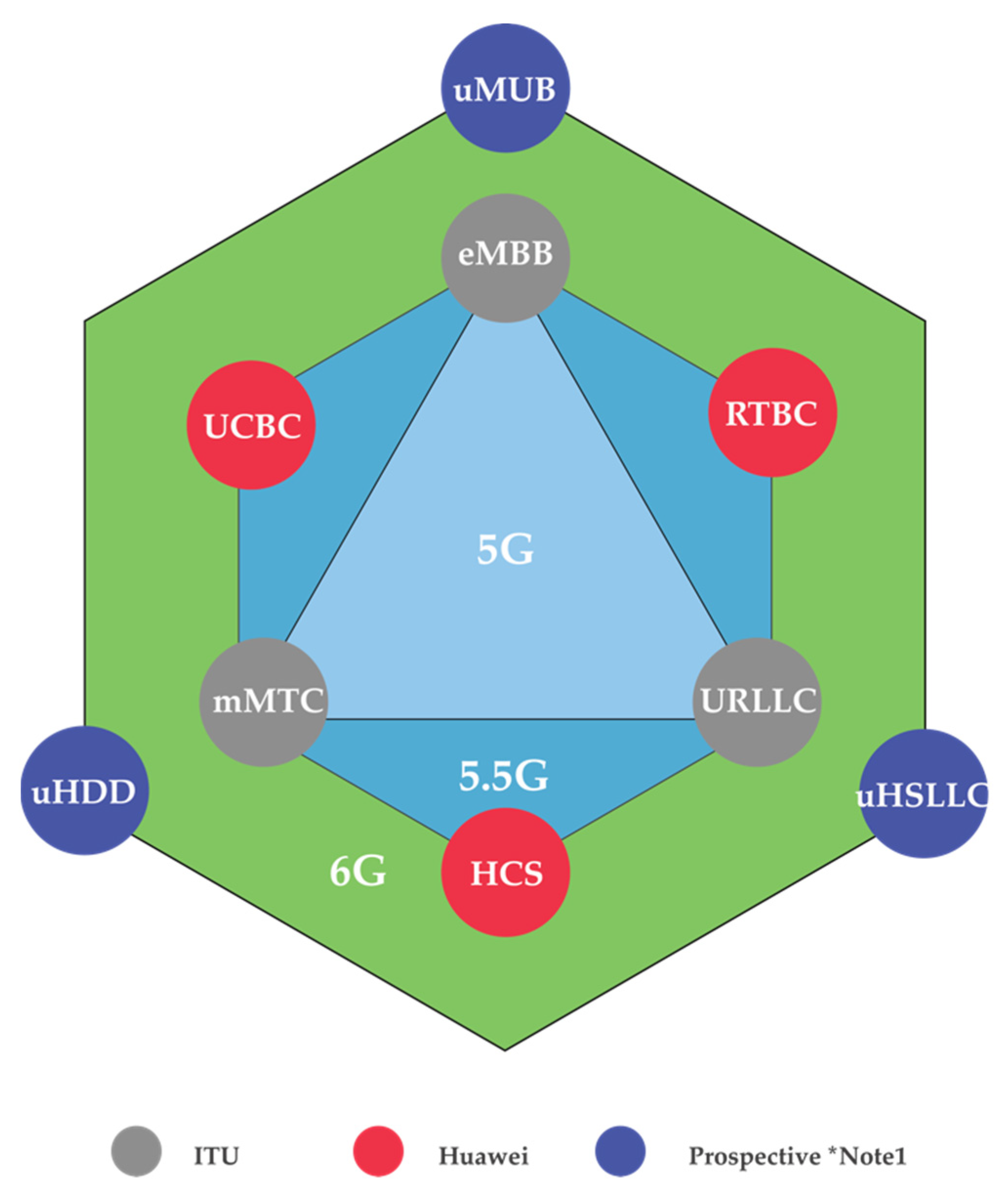


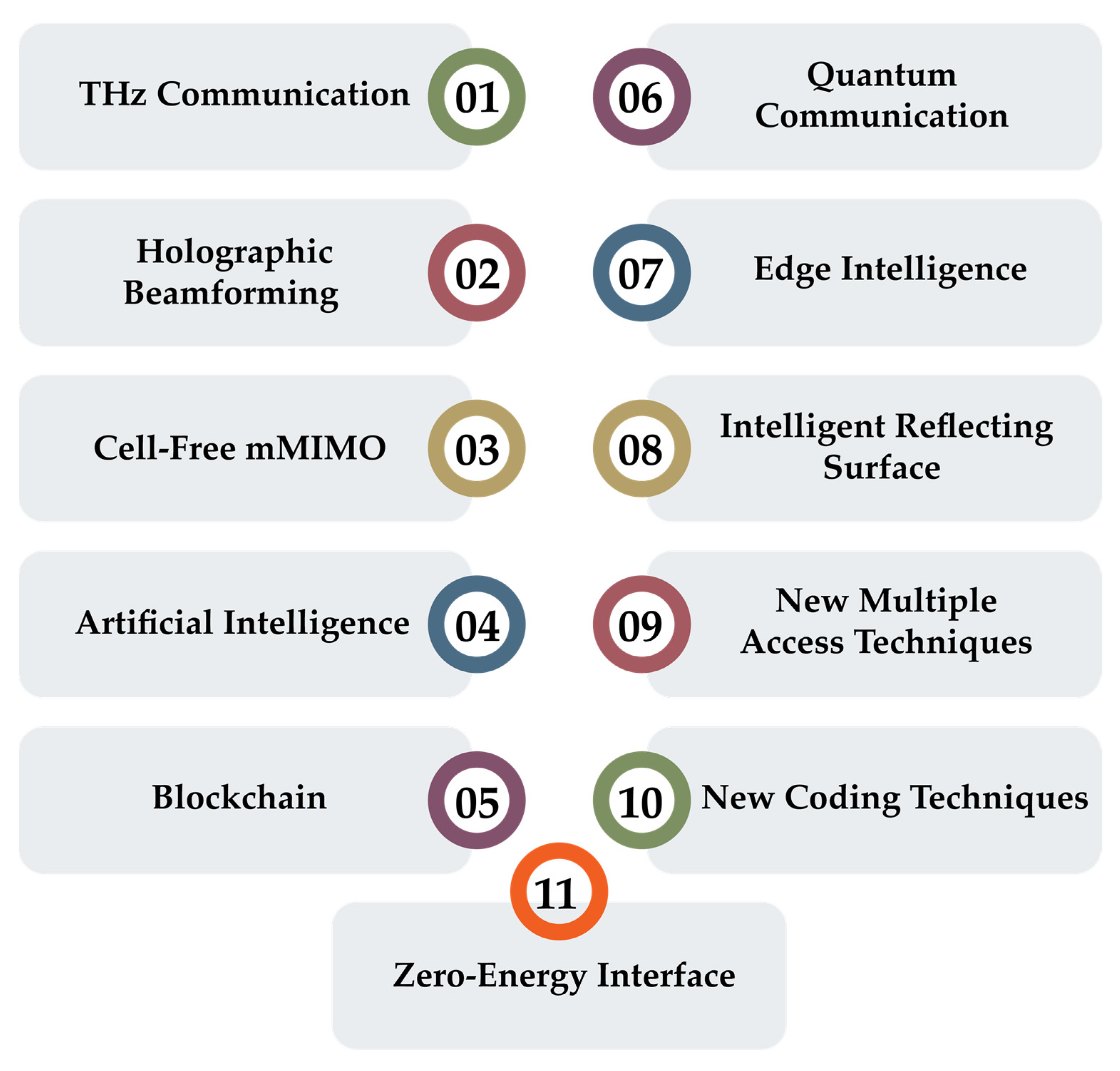
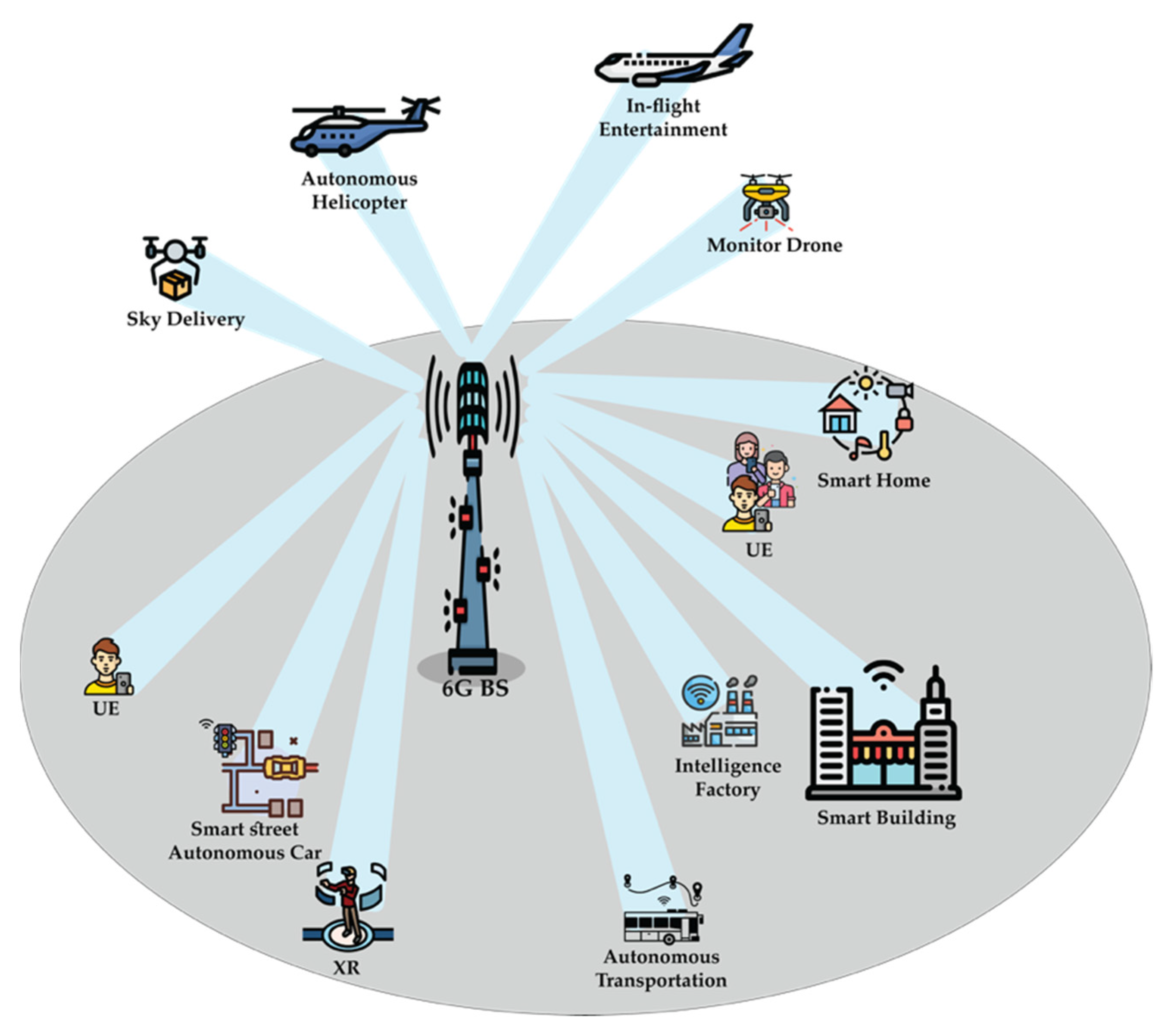
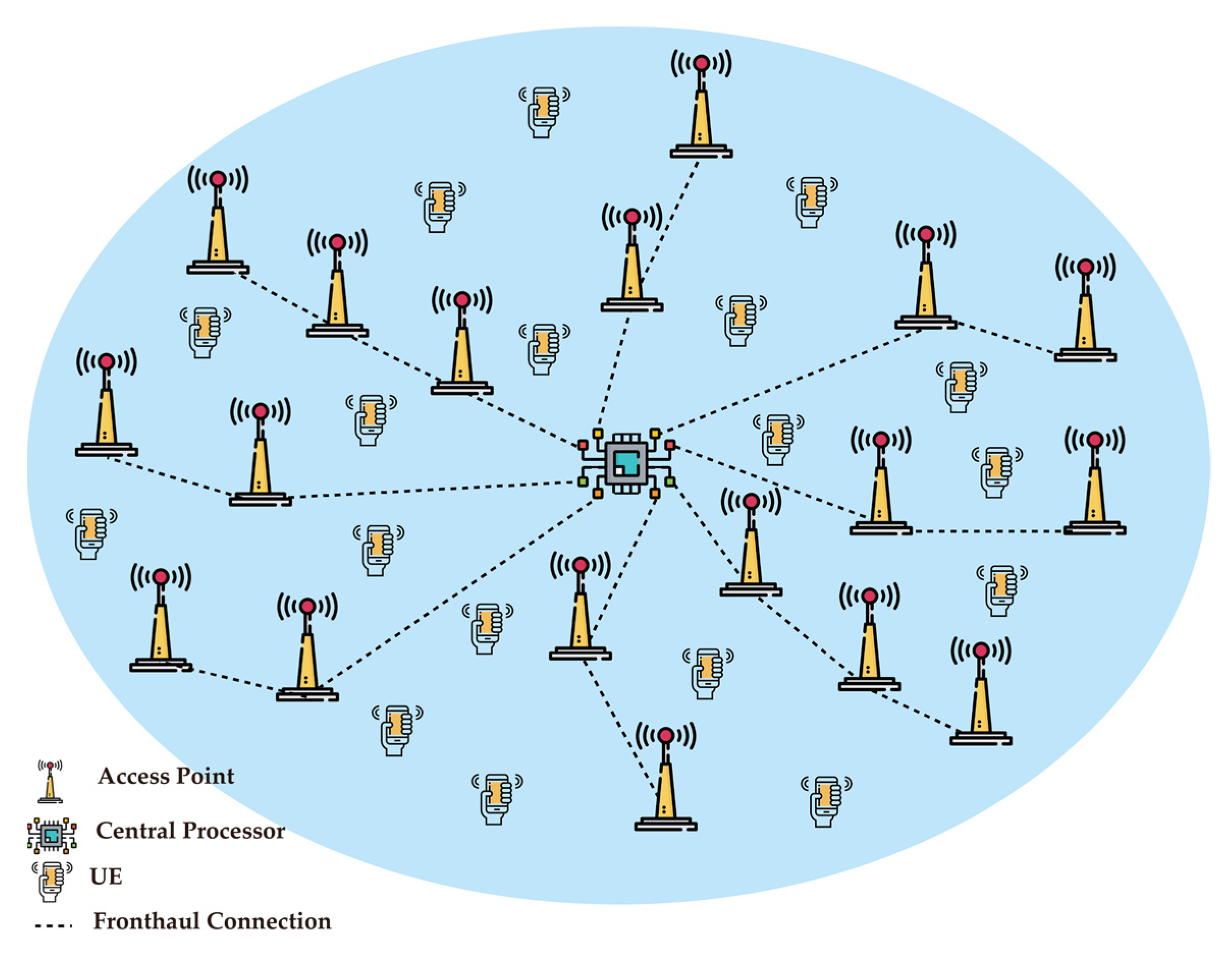
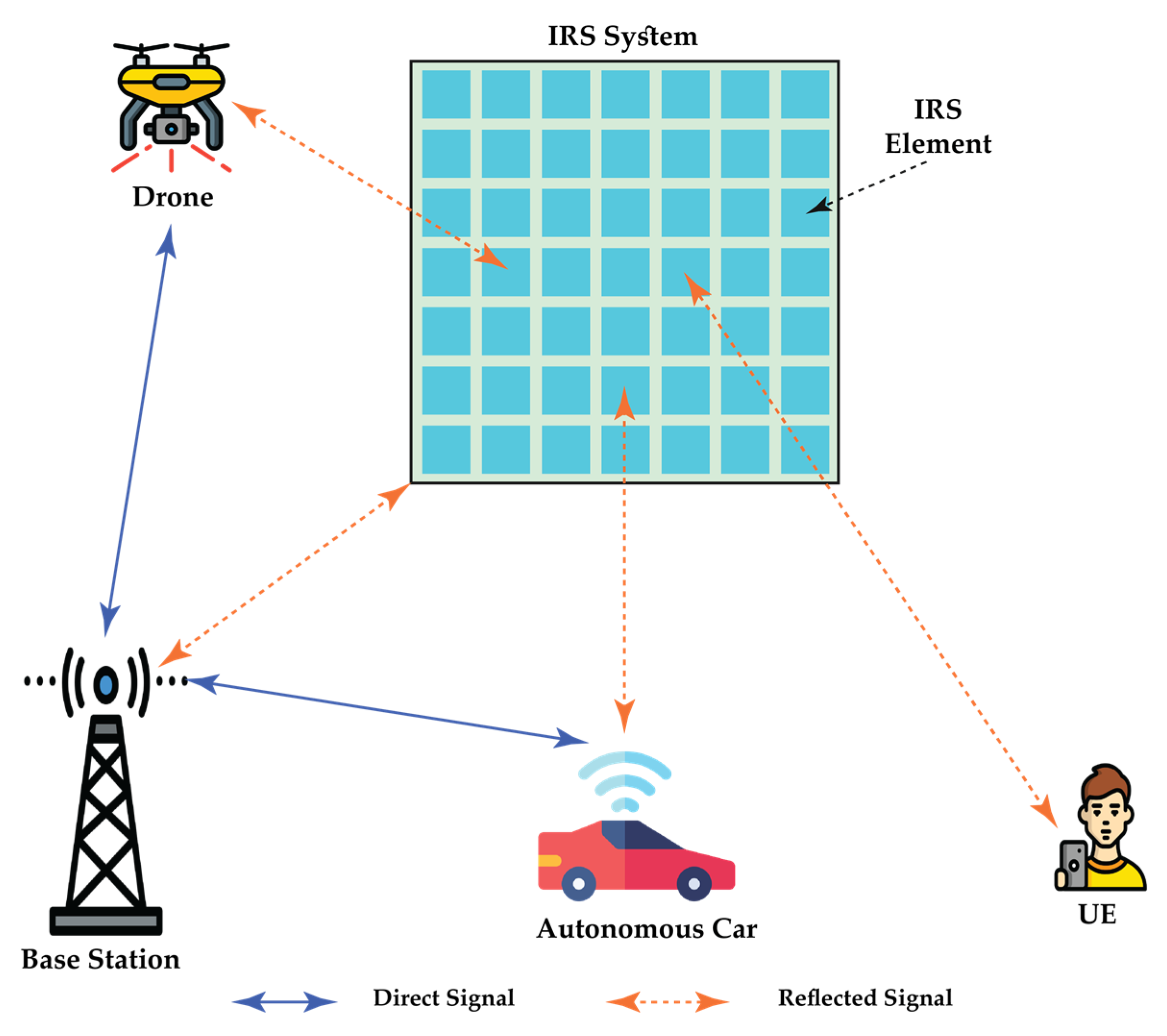
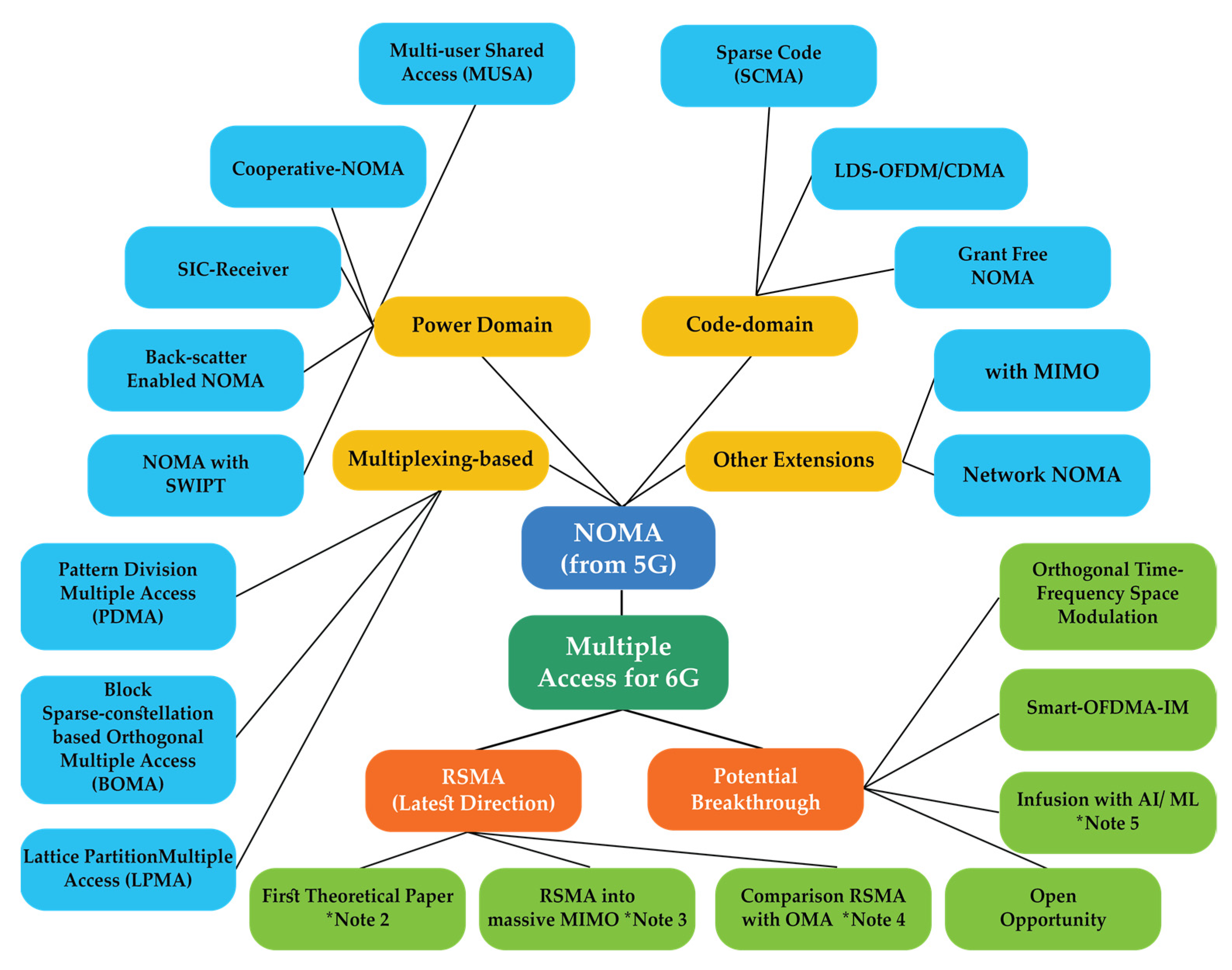
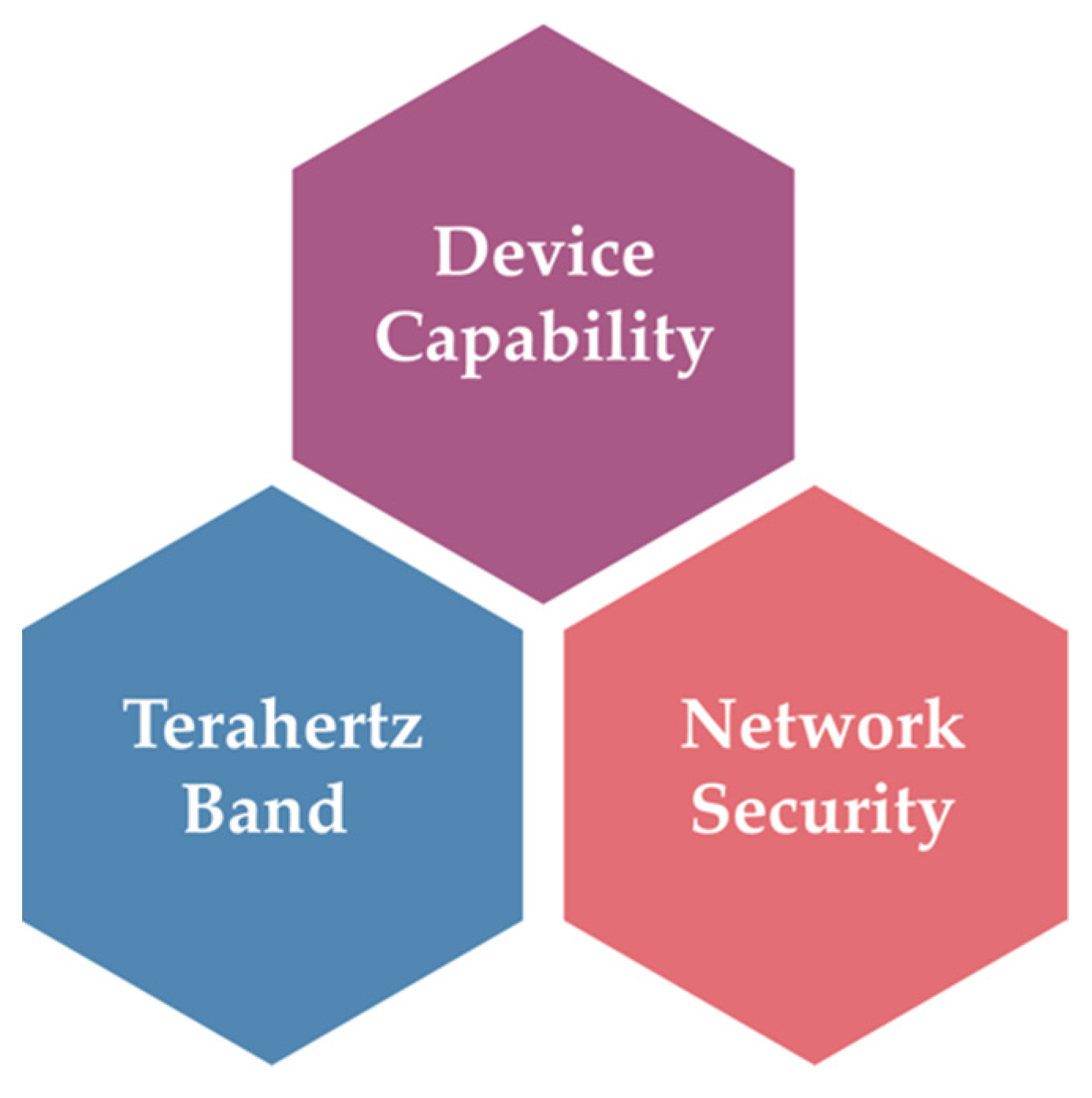
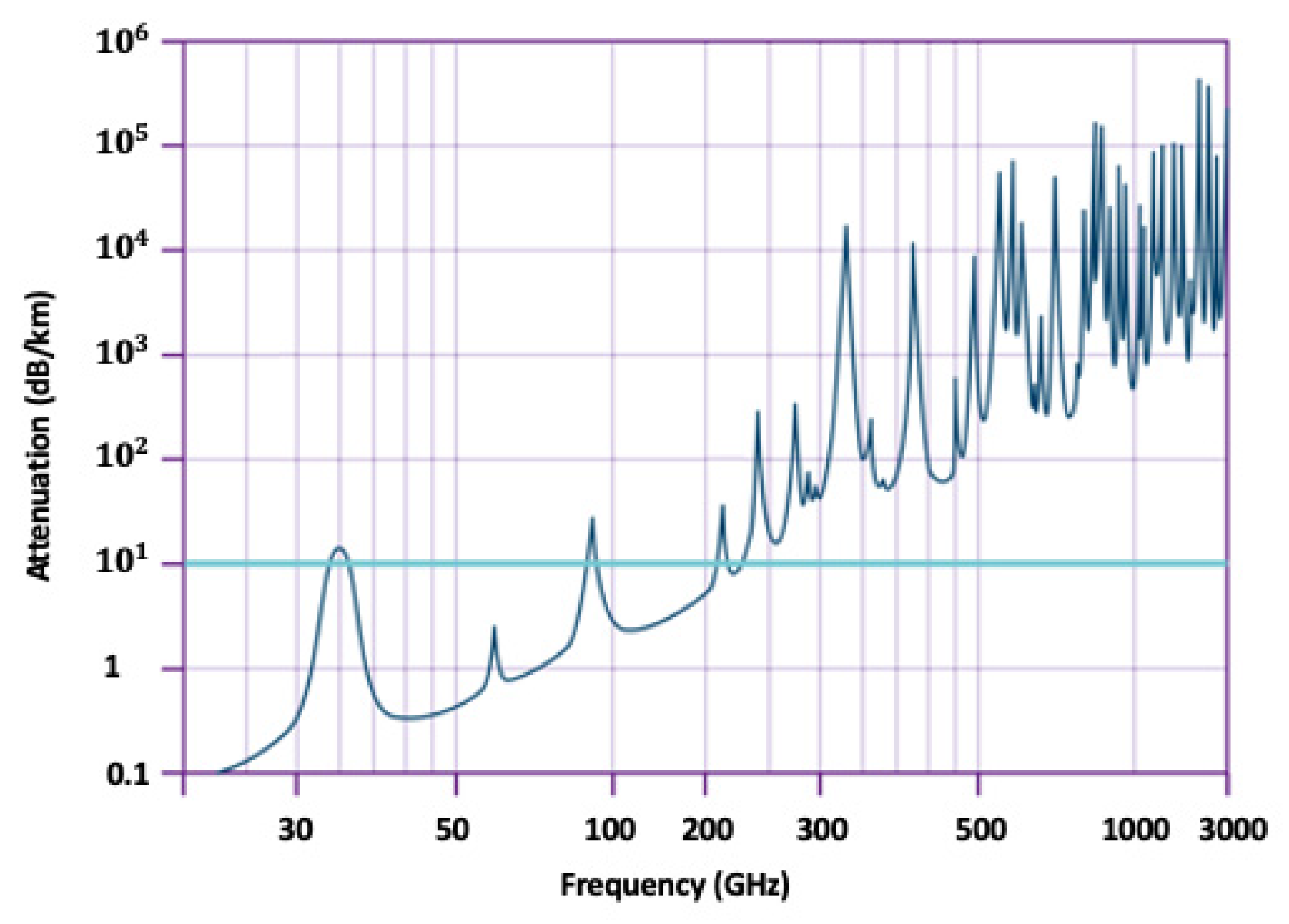
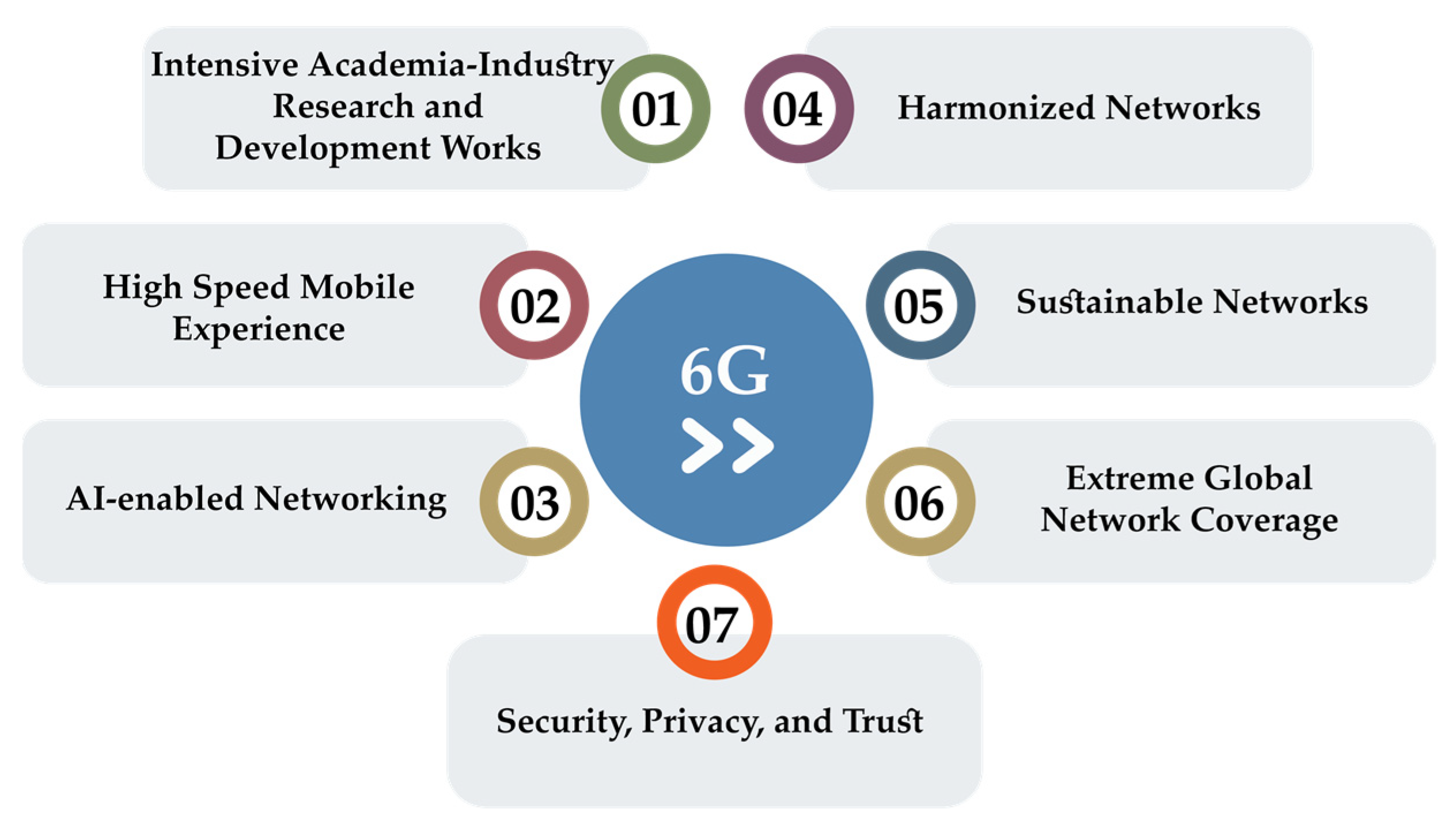
| Characteristic | 5G | 6G |
|---|---|---|
| Operating frequency | 3 GHz–300 GHz | Up to 1 THz |
| Peak data rate | 20 Gbps | 1 Tbps |
| Latency | 1 ms | 10–100 μs |
| Mobility | 500 km/h | >1000 km/h |
| Available spectrum | 30 GHz | 10–100 times higher than 5G |
| Spectral efficiency | 30 bps/Hz | 100 bps/Hz |
| Energy efficiency | High | Ultra-high |
| Connection density | 106 devices/km2 | 107 devices/km2 |
| Coverage | 99.99% | 99.9999% |
| Positioning precision | Meter precision | Centimeter precision |
| Satellite integration | Partial | Fully |
| Automation integration | Partial | Fully |
| Network awareness | Partial intelligibility | Ubiquitous intelligence |
| Reliability | 1–10−5 | 1–10−9 |
| Service level | VR/AR/3D | Tactile |
| XR | Partial | Fully |
| Haptic communication | Partial | Fully |
| Smart city components | Separated | Integrated |
| IRS | - | Yes |
| Standards | 5G/NR | - |
| Core network | IoT | IoE |
| HetNets | Flexible | Ultra-flexible |
| Usage scenarios | EMBB, URLLC & mMTC | uMUB, uHSLLC & uHDD |
| Main technologies | mmWave, mMIMO, UDN, SDN | THz, SM-MIMO, Laser and VLC, Quantum, Blockchain, AI/ML |
| Applications | VR/AR/360° videos, UHD videos, V2X, IoT, Smart city/factory/home, telemedicine, and wearable devices | Holographic, tactile/haptic internet, full-sensory and reality, fully automated driving, industrial internet, space travel, deep-sea sightseeing, and Internet of bio-nano-things |
| Flexible spectrum | Flexible duplex | Free duplex |
| 5G Technology | 6G Technology | ||
|---|---|---|---|
| mmWaves | THz | VLC | |
| Frequency band | 3 GHz–99 GHz | 100 GHz–10 THz | 430 THz–790THz |
| Supporting data rate | Gigabits/second | Terabits/second | Gigabits/second |
| Propagation loss | Low propagation loss (compared to THz) | High propagation loss | High |
| Underwater communication | No | No | Yes |
| Link | NLOS | NLOS | LOS |
| Spectrum | Licensed | Licensed | Unlicensed |
| Electromagnetic interference | Yes | Yes | No |
| Penetrate through opaque objects | Yes | Yes | No |
| Challenges | Circuit design, High propagation loss | Molecular absorption, circuit design challenges, higher propagation loss (compared to mmWave), high penetration loss | Small coverage, require RF uplink, dark objects absorb light waves, suffer from shot noise caused by another light source |
| Environment communication | Indoor/outdoor | Indoor/outdoor | Mostly indoor |
| Potential | Wide bandwidth, small antenna size, focused beams, path loss can be compensated, and allowing spatial multiplexing | High bandwidth (100x mmWave), small antenna size, focused beams | Low-cost hardware, low interference, unlicensed spectrum |
| Potential applications | Small cell access, cellular access, and wireless backhaul | Autonomous vehicles, cloud, mobile HetNets | Li-Fi, visible light ID system, hospital robots, underwater communication, and traffic communication systems |
| Transmission power | High | High | Low |
Publisher’s Note: MDPI stays neutral with regard to jurisdictional claims in published maps and institutional affiliations. |
© 2022 by the authors. Licensee MDPI, Basel, Switzerland. This article is an open access article distributed under the terms and conditions of the Creative Commons Attribution (CC BY) license (https://creativecommons.org/licenses/by/4.0/).
Share and Cite
Alraih, S.; Shayea, I.; Behjati, M.; Nordin, R.; Abdullah, N.F.; Abu-Samah, A.; Nandi, D. Revolution or Evolution? Technical Requirements and Considerations towards 6G Mobile Communications. Sensors 2022, 22, 762. https://doi.org/10.3390/s22030762
Alraih S, Shayea I, Behjati M, Nordin R, Abdullah NF, Abu-Samah A, Nandi D. Revolution or Evolution? Technical Requirements and Considerations towards 6G Mobile Communications. Sensors. 2022; 22(3):762. https://doi.org/10.3390/s22030762
Chicago/Turabian StyleAlraih, Saddam, Ibraheem Shayea, Mehran Behjati, Rosdiadee Nordin, Nor Fadzilah Abdullah, Asma’ Abu-Samah, and Dalia Nandi. 2022. "Revolution or Evolution? Technical Requirements and Considerations towards 6G Mobile Communications" Sensors 22, no. 3: 762. https://doi.org/10.3390/s22030762
APA StyleAlraih, S., Shayea, I., Behjati, M., Nordin, R., Abdullah, N. F., Abu-Samah, A., & Nandi, D. (2022). Revolution or Evolution? Technical Requirements and Considerations towards 6G Mobile Communications. Sensors, 22(3), 762. https://doi.org/10.3390/s22030762











